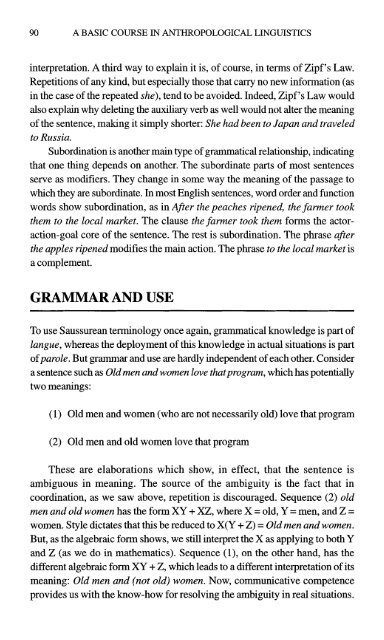A Basic Course in Anthropological Linguistics (Studies in Linguistic ...
A Basic Course in Anthropological Linguistics (Studies in Linguistic ...
A Basic Course in Anthropological Linguistics (Studies in Linguistic ...
Create successful ePaper yourself
Turn your PDF publications into a flip-book with our unique Google optimized e-Paper software.
90 A BASIC COURSE IN ANTHROPOLOGICAL LINGUISTICS<br />
<strong>in</strong>terpretation. A third way to expla<strong>in</strong> it is, of course, <strong>in</strong> terms of Zipf’s Law.<br />
Repetitions of any k<strong>in</strong>d, but especially those that carry no new <strong>in</strong>formation (as<br />
<strong>in</strong> the case of the repeated she), tend to be avoided. Indeed, Zipf’s Law would<br />
also expla<strong>in</strong> why delet<strong>in</strong>g the auxiliary verb as well would not alter the mean<strong>in</strong>g<br />
of the sentence, mak<strong>in</strong>g it simply shorter: She had been to Japan and traveled<br />
to Russia.<br />
Subord<strong>in</strong>ation is another ma<strong>in</strong> type of grammatical relationship, <strong>in</strong>dicat<strong>in</strong>g<br />
that one th<strong>in</strong>g depends on another. The subord<strong>in</strong>ate parts of most sentences<br />
serve as modifiers. They change <strong>in</strong> some way the mean<strong>in</strong>g of the passage to<br />
which they are subord<strong>in</strong>ate. In most English sentences, word order and function<br />
words show subord<strong>in</strong>ation, as <strong>in</strong> After the peaches ripened, the farmer took<br />
them to the local market. The clause the fanner took them forms the actor-<br />
action-goal core of the sentence. The rest is subord<strong>in</strong>ation. The phrase afer<br />
the apples ripened modifies the ma<strong>in</strong> action. The phrase to the local market is<br />
a complement.<br />
GRAMMAR AND USE<br />
To use Saussurean term<strong>in</strong>ology once aga<strong>in</strong>, grammatical knowledge is part of<br />
langue, whereas the deployment of this knowledge <strong>in</strong> actual situations is part<br />
ofparole. But grammar and use are hardly <strong>in</strong>dependent of each other. Consider<br />
a sentence such as Old men and women love thatprogram, which has potentially<br />
two mean<strong>in</strong>gs:<br />
(1) Old men and women (who are not necessarily old) love that program<br />
(2) Old men and old women love that program<br />
These are elaborations which show, <strong>in</strong> effect, that the sentence is<br />
ambiguous <strong>in</strong> mean<strong>in</strong>g. The source of the ambiguity is the fact that <strong>in</strong><br />
coord<strong>in</strong>ation, as we saw above, repetition is discouraged. Sequence (2) oZd<br />
men and old women has the form XY + XZ, where X = old, Y = men, and Z =<br />
women. Style dictates that this be reduced to X(Y + Z) = Old men and women.<br />
But, as the algebraic form shows, we still <strong>in</strong>terpret the X as apply<strong>in</strong>g to both Y<br />
and Z (as we do <strong>in</strong> mathematics). Sequence (l), on the other hand, has the<br />
different algebraic form XY + Z, whch leads to a different <strong>in</strong>terpretation of its<br />
mean<strong>in</strong>g: Old men and (not old) women. Now, communicative competence<br />
provides us with the know-how for resolv<strong>in</strong>g the ambiguity <strong>in</strong> real situations.






